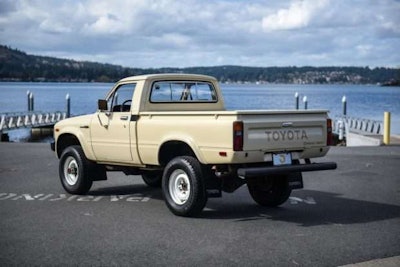Not to sound too much like the late Andy Rooney, but you ever notice how you don’t see many compact pickups anymore? Is bigger really always better?
While out driving the other day, one of my kids made a thought-provoking comment about the latest pickup offerings. “Dad, there’s full-size and mid-size, but no small size.”
So true. In the greatest marketplace in the world, where we’re so accustomed to choosing ‘small, medium or large’ things, the small pickup option has been yanked off the table. However, the value certainly remains.
The first vehicle I learned to drive was a four-speed 1984 Toyota pickup. That was in 1987. (Geez…I just caught myself writing ‘four-speed.’ You don’t see that in print much anymore.)
It was the first new vehicle Mom had ever bought. It was sold a few years later because Dad, a Marine, had gotten orders to transfer from Camp Pendleton to MCLB, Albany, Ga.
The new owner, an older teen, wrecked the truck not long after. Too bad. I had regularly washed and cleaned that pickup. It was in pristine condition at the time of sale.
Now, Japanese trucks from the 1980s are commanding high prices. Seems small is not so small after all.
Hagerty recently published an interesting article detailing the increased demand for compact trucks, with Toyota and Nissan pickups leading the way. (What? Did you forget about the Subaru Brat?)
“If you’ve been reading our valuation articles, then you know that Japanese classics are hot. You could be excused, however, for not knowing that the next big thing is—you read it here first—classic Japanese pickup trucks,” the lead paragraph states.

The two-owner truck had undergone transmission work and a power steering retrofit by a Toyota specialist. The interior, replete with that signature Toyota vinyl floor, is in good shape. (More photos from bringatrailer.com plus a vintage Toyota commercial are posted below).
Of course, no article on vintage Japanese trucks would be complete without referencing the strange tit-for-tat chicken tax. Hagerty does a great job summing up how the fowl tax eventually led to higher prices on imported autos. This is a good read for young people who would appreciate a quick study of international economics.
“Toyota and Nissan have sold small pickups since the late 1950s. Not in any large numbers however. And, the United Auto Workers (UAW) aimed to keep it that way. When Europeans slapped a punitive 25 percent tax on American chickens, we responded with a 25 percent tax on imported potato starch and brandy.
“This trade war was an opportunity for a deal between President Johnson and the UAW, which added imported pickup trucks to the already bizarre list. Thus, the infamous “chicken tax” was applied. Due to the exchange rate, German trucks like the Microbus-based VW pickup disappeared almost overnight. But for a while, Japanese car companies were able to absorb the tax hit.
“Manufacturers also found inventive ways to avoid the tax. Chevy LUVs and Ford Couriers, built abroad, were imported without beds as commercial vehicles and Subaru created the BRAT by placing two seats in the bed of a small pickup thus creating a passenger vehicle. The first Toyota 4Runner was simply a Hilux pickup with a topper shell and back seats.”

“For now, we recommend scouring Craigslist in rural Northern California, Oregon and Washington,” Hagerty reports. “And if you’re already priced out of the market, you might consider looking for a first-generation Nissan Hardbody pickup (built in the U.S. to circumvent the chicken tax) or even a first-generation two-door Pathfinder. Other Toyota truck-based SUVs, like first-gen 4Runners, are already getting pricey. The secret here is that the second-generation 4Runner is nicer and better looking. Grab one with a rare five-speed. The upper limits of their lifespan have yet to be determined—a 200,000 mile 4Runner is just getting broken-in.”
Be advised however, that not everyone in California is—no surprise—catching on.
“Interestingly, the word hasn’t quite reached the most remote pockets of the vintage Toyota truck’s natural habitat—places like Medford, Ore., and Yreka, Calif., where vintage Toyota trucks still do regular duty tending illicit botanical projects,” Hagerty writes.
Oh, what a feeling! Check out the pictures and the vintage Toyota truck commercial below which features the automaker’s once-supremely popular catchphrase, “Oh, what a feeling!”















